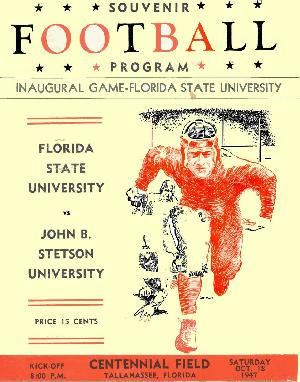
1947 Stetson-FSU Game Program
Building Blocks
By Jim Joanos
In 1993, Florida State won its first national championship. The event signaled to the football world that FSU would thereafter be among those who have attained the highest level in football. Although in the modern era, FSU had only been playing football for 47 years, that championship ended the notion that FSU was but a beginning football program.
From 1993 on, FSU football entered into a new phase. It won another championship in 1999. From 1993 through 2000, the team finished each season no lower than in fifth place in the Associated Press poll. Even though the program has not done quite as well since, it continues to be regarded as one of the nation's important programs.
There was not a single reason that enabled FSU to reach this status. There were lots of events and lots of games that occurred along the way. There were also many players, coaches, administrators and fans involved. Space in a single article does not allow us to explore the subject in any great detail. However, let us discuss ten of the most important and most interesting games that occurred along the way from those beginning days until the famous 1993 season.
The First game
October 18, 1947, Tallahassee
Stetson 14, Florida State
6
 |
1947 Stetson-FSU Game Program |
Every journey starts with a single step. There were nearly 8,000 of us jammed into Centennial Field, the old minor league baseball park which had bleacher seating for only about 6,000 to see Florida State's first football game since 1904. Centennial Field was a wonderful old time venue. Train tracks ran around two sides of the field. Occasionally, during games, a train would go chugging by with smoke coming out of its stack.
1947 FSU Football Coaching Staff |
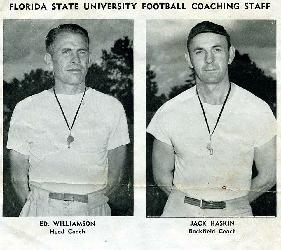 |
Ed Williamson, Head Coach and Jack Haskin, Backfield Coach |
FSU's coach was a man named, Ed Williamson. He had grown up in Tallahassee and played football at the University of Florida. It was a great coincidence that Stetson was the opponent that night for Stetson had been the last team that Florida State College had played and beaten in 1904 when Florida State won the state championship. In the year following that 1904 game, football was discontinued at the school as it was transformed into a women's college.
The 1947 game got off to a great start with FSU having the early momentum. FSU scored first, in the second quarter, when quarterback Don Grant threw a touchdown pass to receiver Charles McMillan in the end zone. But FSU would not score again, and a better organized, more experienced Stetson team scored two touchdowns to win the game. Although FSU lost, there was proof that FSU football would be popular.
The first bowl game
January 2, 1950, Cigar Bowl, Tampa
Florida State 19,
Wofford 6
Don Veller became FSU's head coach in 1948. Following Veller's arrival, the team became very successful playing some of the smaller southern college football teams. By the end of the 1949 regular season, FSU's third in modern times, the team was invited to its first ever bowl game.
The Fourth Annual Cigar Bowl pre-game festivities in Tampa featured a giant Cigar Box from which emerged a beautiful queen. On the field that day before the 14,000 fans in attendance, Florida State, pummeled its opponent - small-college powerhouse Wofford College of Spartanburg, S.C.
Wofford had entered the game sporting a 1949 season record of 11-0, and not having lost a game in over two years. Pre-game predictions from the experts had Wofford winning by at least two touchdowns and as much as thirty-five points. Wofford was ranked higher than a number of well established major college programs including Colorado, Maryland, and Arizona. The Dixie Conference champion Seminoles had gone 8-1 during the season but were expected to put up very little resistance to the Wofford juggernaut.
The game started out as expected when with only about two minutes into the game, Wofford blocked a punt and took it in for a touchdown. Few suspected that Wofford would not score again. However, it was all FSU, the remainder of the game.
There were lots of FSU stars that day, but the brightest was fullback-defensive end Theo "Buddy" Strauss who sparkled on both sides of the ball. On offense, Strauss led all ball carriers in compiling 132 yards rushing and another 20 passing in completing two of four attempts. His total offense of 152 yards was more than the 139 yards gained by the entire Wofford team. On defense, Strauss slammed through the line over and over again making big play after big play.
First victory over an SEC team
October 25, 1958, Knoxville, Tennessee
Florida State 10, Tennessee 0
When FSU restarted football in 1947, most of the best football programs in our area of the country were members of the Southeastern Conference. If FSU was ever to be given respect as an accomplished football program, it would have to be able to hold its own against teams of the quality of the SEC. Therefore, when the Seminoles under the leadership of Coach Tom Nugent went up to Knoxville and not only obtained the first victory against an SEC team but shut out Tennessee, it was a major accomplishment.
There are lots of good stories about that game. FSU's two captains were two Tennessee natives, quarterback Joe Majors, and back Fred Pickard. Majors had a great game that day leading the Seminoles. His brother, Billy, played quarterback for Tennessee but was injured early in the game and could not play further.
FSU's Fred Pickard, from Columbia, Tennessee, led all ball carriers in gaining 133 yards for the day. The University of Tennessee had not recruited Pickard because as a 133-pound high school running back he was considered too little to play major college ball.
Bill McGrotha in his 1987 book, Seminoles! The First Forty Years, wrote about the welcome home that the team received following the game: "Thousands of welcoming fans - among them Gov. LeRoy Collins - swarmed Tallahassee's old airport at Dale Mabry Field as FSU's chartered flight returned from what some still consider the Seminoles' biggest victory of all time. Estimated at 3,000, that crowd would dwarf most such in the years that followed."
First game against the University of Florida
November 22, 1958,
Gainesville
Florida 21, Florida State 7
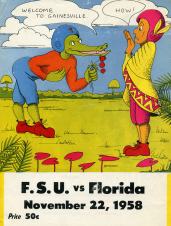 |
1958 FSU-Florida Game Program |
In 1958, FSU finally got the opportunity to play the University of Florida in football. FSU lost the game, but it was a major step forward in FSU's progress. This was the first FSU vs UF game in modern times and it took acts of government to get it done. Legislative attempts to force the game and the promise of more to come along with pressure from numerous public officials eventually forced the University of Florida to agree to play the Seminoles.
FSU received the opening kickoff and the game started off with a bang. Halfback Jack Espenship got the kick and handed off to Bobby Renn who followed blocker Bob Swoszowski. Seventy-eight yards later, Renn was tackled on the Gator 15-yard line. Shortly afterwards, the Seminoles scored and it was 7-0. Although FSU played tough throughout most of the game, the Seminoles were out-manned and lost 21-7. FSU lost the game but a big time rivalry was born.
A big homecoming game
October 10, 1964, Tallahassee
Florida State 48,
Kentucky 6.
The 1964 season was the sixth at FSU for head coach Bill Peterson. For some unknown reason, FSU chose the Kentucky game early in the 1964 season as its homecoming game for the year. FSU had won all three of its first games by shutouts: 14-0 at Miami, 10-0 at Texas Christian, and 36-0 at home against New Mexico State.
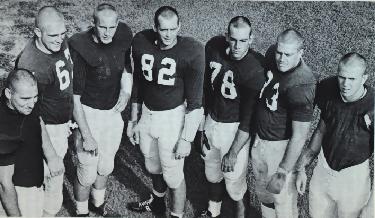 |
Seven Magnificents |
Yes, that is correct, the FSU defense led by the "Seven Magnificents" (the nickname bestowed upon the front seven, all of whom had their heads shaved in preseason practice) had not allowed a point to be scored against them in all three games. But despite that, Kentucky came into Doak Campbell Stadium the heavy favorite for they, too, were undefeated (they had previously beaten Misissippi and Auburn) and most importantly ranked fifth in the country.
FSU totally demolished the Wildcats. The score was 21-0 after one quarter, 27-0 at halftime, and 48-0 until the final moments of the game when Kentucky finally scored after a fumbled punt by an FSU player.
Up until then, the 48-6 victory was easily the biggest FSU victory of all time, and gave FSU a 4-0 start to the season. In his 1987 book, McGrotha describes the reaction by the media: "Announcers, disclosing the score on national TV and radio, entered disclaimers. 'Surely, this must be a mistake, with the score reversed,' said one."
Florida State continued its winning ways that season, suffering only one upset loss on the road to Virginia Tech and a tie at Houston when star wide receiver Fred Biletnikoff was injured and unable to contribute. Regular season victories included two very important ones, one at Georgia, and the first ever victory over Florida in the first FSU-Florida game played in Tallahassee since FSU started play in 1947. At the end of the season, FSU was invited for the first time to play in Jacksonville's Gator Bowl game.
FSU's first Gator Bowl
January 2, 1965, Gator Bowl, Jacksonville
Florida State 36, Oklahoma 19.
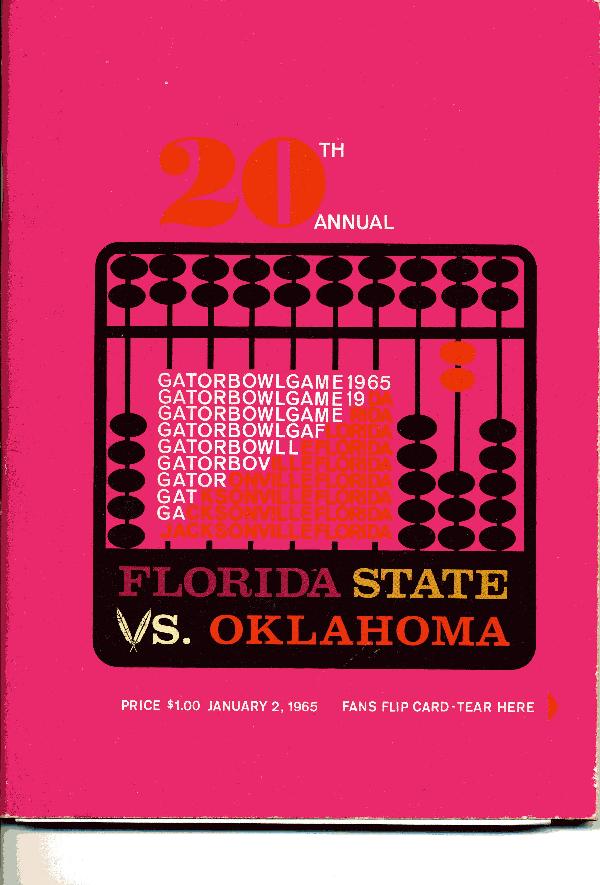 |
1965 Gator Bowl Game Program |
At the end of the 1964 season, FSU was invited to play Okalahoma in the Gator Bowl in Jacksonville. The game turned out to be a showcase for FSU's passing game and had a major effect upon the future of college football as FSU demolished Oklahoma 36-19. FSU's quarterback, Steve Tensi completed 23 of 36 passes for 303 yards and five touchdowns that day. Four of those five touchdown passes were caught by FSU's very first consensus All-American, Fred Biletnikoff.
Viewing FSU's success under Coach Bill Peterson in the use of a predominantly passing offense during the 1964 season and in the Gator Bowl, other college teams began placing more importance on the passing game. There is no doubt that FSU was an early leader in the revolution of college football.
Today, the forward pass is a main ingredient in most offensive schemes. Before the 1964 season, it was used primarily as a "trick play" or when the team fell behind, it might be used in desperation. As a result of the 1964 season, FSU first obtained credit as an innovator, a reputation that has continued under present coach Bobby Bowden.
A tie better than kissing your sister
September 23, 1967, Birmingham,
Alabama
Florida State 37, Alabama 37
When FSU began the 1967 season by losing at Houston, 13-33, it looked like a bad season ahead. But in the very next game, FSU caught the nation's eye when the team went into Legion Field in Birmingham, Alabama, and tied the number two ranked team in the country, the University of Alabama, 37-37.
Later that year, the American Broadcasting Company aired a documentary on Alabama's legendary coach, Paul "Bear" Bryant, which included footage from the FSU-Alabama game. At one point in the film, Bryant is shown yelling, "What the Hell is going on out there?" as FSU's Walt Sumner returned a punt for a touchdown.
The game was a passing shootout throughout featuring FSU's passing tandem of Kim Hammond to Ron Sellers and Alabama's of Ken "Snake" Stabler to Dennis Homan. When the game had ended FSU had once again returned to the national spotlight.
Although FSU would lose its next game at North Carolina State, it would go on to a 7-2-1 regular season and tie Penn State and famed head coach Joe Paterno, 17-17 in FSU's second trip in four years to the Gator Bowl. The Alabama game together with the 1967 season's success erased the notion that FSU's 1964 season was "just a fluke." Instead, FSU gained confidence in the belief that it could compete successfully in continuity.
"They're back"
December 3, 1977, Gainesville
Florida State 37, Florida
9
Bobby Bowden became FSU's head coach beginning with the 1976 season. The team had only won four games in the three previous years. Improvement did not come immediately, as FSU lost its first three games of the 1976 season. But then things started to improve as the Seminoles won five of their last eight games. Of especial interest was the 26-33 loss to Florida in which the Seminoles had a chance to win the game in the late moments. Although things were looking up, Coach Bowden let it be known that he would not consider the program turned around until FSU had beaten the University of Florida.
The turn around became complete when in the last game of the 1977 season, the Seminoles went to Gainesville and hammered the Gators. The FSU attack featured the two-headed quarterback combination of Wally Woodham and Jimmy Jordan along with one of the best group of receivers in school history, before or since, that included Kurt Unglaub, Roger Overby, and Mike Shumann.
The game concluded the 1977 regular season with 9-2 record and got the Seminoles an invitation to the Tangerine Bowl in Orlando, where they soundly defeated Texas Tech 40-17. That season, the Seminoles finished the season ranked 14th in the country by the Associated Press. The return to "the big time" for FSU football has continued since.
A touch of class
October 4, 1980, Lincoln, Nebraska
Florida State 18,
Nebraska 14
One of the biggest FSU plays of all time occurred at Lincoln, Nebraska, in 1980. Late in the game with FSU leading 18-14, Nebraska drove all the way to the Seminole 3-yard line for a first down with only 21 seconds left in the game. Nebraska, at the time a contender for the national championship, looked certain to conclude the game with a victory in the waning moments. On first down, the Nebraska quarterback's pass was incomplete. Then on second down he rolled out to the left. FSU linebacker Paul Piurowski went after him and hit him forcing a fumble. Seminole lineman Garry Futch pounced on the ball and FSU had itself one of its biggest road wins ever.
The game proved to be a harbinger of things to come as Florida State under Coach Bowden's leadership went on to become very successful road warriors earning the reputation as being "willing to play any team, anywhere, anytime, and beat them." The Seminoles had previously won at LSU in 1980, and in 1981 won at Ohio State, Notre Dame, and again at LSU. Consequently, in the early eighties Bowden became known as the "King of the Road".
The 1980 Nebraska game was also important for what was learned by the officials and fans of FSU about the importance of class in a football program. When visiting FSU fans arrived in Lincoln, they were immediately impressed by the warm and friendly greeting that they received. The Nebraska supporters were not only most gracious but invited the FSU people to their tailgates and shared food and drink with them.
During the game, the nearly 80,000 red clad fans cheered for the Cornhuskers throughout but never once booed the Seminoles. The biggest surprise of all came at the conclusion of the game. Although it had been a hard fought contest and although FSU had delivered a severe blow to Nebraska's quest for a national championship, the fans stood and cheered both teams as they left the field. To this day, FSU continues its quest to emulate the class of the Nebraska fans observed on that wonderful day in 1980.
A big time in the big house
September 28, 1991, Ann Arbor, Michigan
Florida State 51, Michigan 31
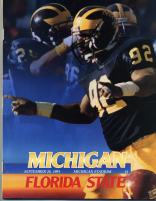 |
1991 FSU-Michigan State Game Program |
As early as 1987, when FSU finished second in the Associated Press poll, the Seminoles had flirted with the serious possibility of winning a national championship. That elusive championship would not come until 1993. However, many believe that the best football team that FSU put on the field prior to the championship year was in 1991 when the Seminoles carried the national championship hopes all the way until the last two games of the regular season.
Those same people believe that until the team was decimated by double-digit injuries in the eight game of the season against LSU on a rainy night in Baton Rouge, it was unquestionably the best team in the land. This writer agrees with that view.
FSU was at the height of its game that season when it went to Ann Arbor in the fourth game of the season. Not only was the game before 106,145 fans in attendance but the entire football nation's eyes were upon the nationally televised match. The game was between No. 1 FSU and No. 3 Michigan and some labeled it as "one of the games of the century," if you will excuse the hackneyed expression.
Those of us in attendance were "packed in like sardines." Looking around, it seemed like only yesterday that FSU was just beginning football in 1947, but here we were, on the country's main stage in a most historic setting. The excitement did not take long to begin. Michigan took the kickoff and moved to its own 40-yard line. Then on the very first play from scrimmage, FSU's Terrell Buckley intercepted a pass in the flat thrown by Michigan's Elvis Grbac and ran it back for a touchdown.
Throughout, it was an exciting game with lots of scoring by both teams with FSU winning out. It was a "big game on a big stage" and FSU gained national exposure and acclaim. There has been lots of that since.
Revisiting old games is a favorite pastime of mine. Hopefully, you have enjoyed the memories. If I left out your favorite games, excuse me. I will try to do better next time.